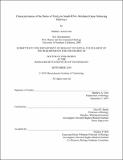Characterization of the roles of Xrn1p in small-RNA-mediated gene-silencing pathways
Author(s)
Getz, Matthew Aaron.
Download1138018868-MIT.pdf (16.26Mb)
Other Contributors
Massachusetts Institute of Technology. Department of Biology.
Advisor
David P. Bartel.
Terms of use
Metadata
Show full item recordAbstract
RNA interference (RNAi) is a small-RNA-mediated gene-silencing pathway that is involved in viral defense, transposon silencing, heterochromatin formation, and post-transcriptional gene silencing. Most RNAi pathways are initiated by long, dsRNA which is processed by Dicer into small interfering RNAs (siRNAs). These siRNAs are then loaded into an effector protein Argonaute forming the RNA-induced silencing complex (RISC). RISC is then able to silence its target RNAs in a variety of fashions, including by slicing them. RNAi is ubiquitous in eukaryotes with pathways found in plants, animals and fungi, suggesting its early origins and importance. Despite the usefulness of this pathway as a mechanism of genomic defense, the model budding yeast species, Saccharomyces cerevisiae, does not possess an RNAi pathway. Although S. cerevisiae does not possess an RNAi pathway, several related budding yeast species do, including Naumovozyma castellii and Vanderwaltozyma polyspora. Each of these species possesses orthologs of Dicer and Argonaute and has a population of 21-23-nt siRNAs that map to repetitive regions of the genome, including Ty transposable elements and Y' subtelomeric repeats. Disrupting either Dicer or Argonaute causes the loss of these small RNA populations. Additionally, RNAi in N. castellii can silence an exogenous GFP gene. Over-expressing Dicer and Argonaute in S. cerevisiae restores a functioning RNAi pathway that can silence endogenous transposable elements and an exogenous GFP gene. To identify other factors that act in the budding-yeast silencing pathway, we performed an unbiased genetic selection in N. castellii. This selection identified Xrn1p, the cytoplasmic 5'-to- 3' exoribonuclease, as a cofactor of RNAi in budding yeast. Deletion of XRN1 impaired gene silencing in N. castellii and this impaired silencing was the result of multiple functions of Xrn1p. These functions include affecting the amount of different siRNA species in the cell, influencing the efficiency of loading these siRNAs into Argonaute, degradation of cleaved passenger strand, and degradation of cleaved target RNA. XRN1 has also been implicated in miRNA-mediated silencing in human cells. We found that disrupting XRN1 in a human cell line had no effect on the levels of mature miRNAs or their passenger strands but did de-repress miRNA targets, suggesting that in the miRNA pathway, XRN1 functions to degrade target mRNAs.
Description
This electronic version was submitted by the student author. The certified thesis is available in the Institute Archives and Special Collections. Thesis: Ph. D., Massachusetts Institute of Technology, Department of Biology, 2019 Cataloged from student-submitted PDF version of thesis. Vita. Includes bibliographical references.
Date issued
2019Department
Massachusetts Institute of Technology. Department of BiologyPublisher
Massachusetts Institute of Technology
Keywords
Biology.